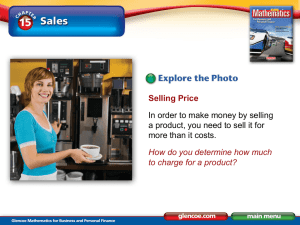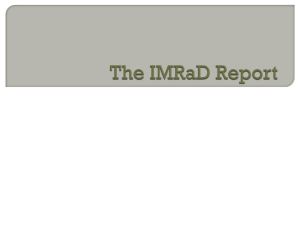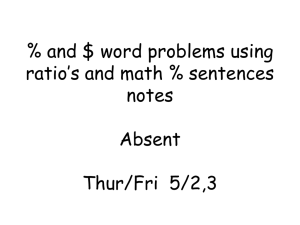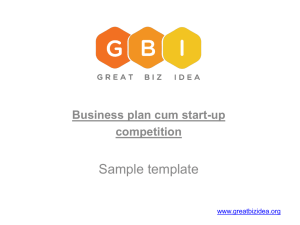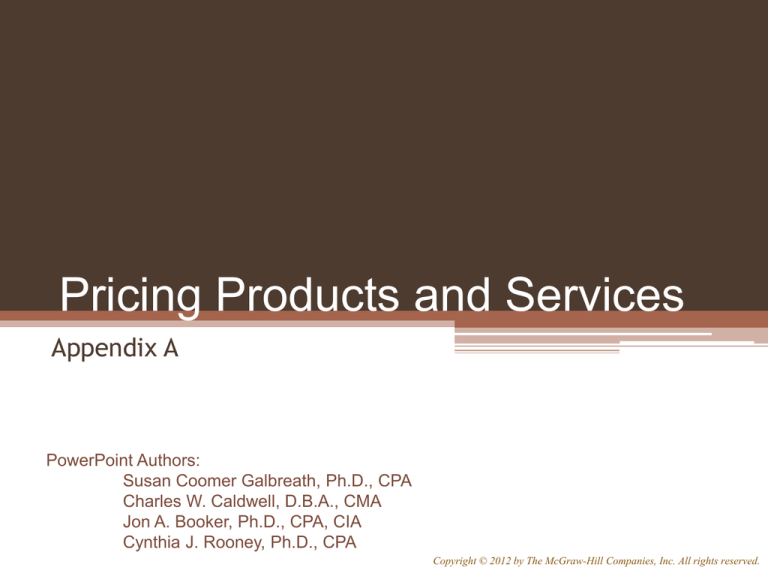
Pricing Products and Services
Appendix A
PowerPoint Authors:
Susan Coomer Galbreath, Ph.D., CPA
Charles W. Caldwell, D.B.A., CMA
Jon A. Booker, Ph.D., CPA, CIA
Cynthia J. Rooney, Ph.D., CPA
Copyright © 2012 by The McGraw-Hill Companies, Inc. All rights reserved.
Appendix A-2
The Economists’ Approach to Pricing
Elasticity of Demand
The price elasticity of demand measures the degree
to which the unit sales of a product or service are
affected by a change in unit price.
Change
Change
in
versus in Unit
Price
Sales
Appendix A-3
Price Elasticity of Demand
Demand for a product is inelastic if a
change in price has little effect on the
number of units sold.
Example
The demand for designer
perfumes sold at cosmetic
counters in department
stores is relatively inelastic.
Appendix A-4
Price Elasticity of Demand
Demand for a product is elastic if a
change in price has a substantial effect on
the number of units sold.
Example
The demand for gasoline is
relatively elastic because if a
gas station raises its price,
unit sales will drop as
customers seek lower prices
elsewhere.
Appendix A-5
Price Elasticity of Demand
As a manager, you should set higher
(lower) markups over cost when
demand is inelastic (elastic)
Appendix A-6
Price Elasticity of Demand
ln(1 + % change in quantity sold)
Єd =
ln(1 + % change in price)
Price elasticity of demand
Natural log function
I can estimate the price
elasticity of demand for a
product or service using
the above formula.
Appendix A-7
Price Elasticity of Demand
Suppose the managers of Nature’s Garden believe
that every 10 percent increase in the selling price
of its apple-almond shampoo will result in a 15
percent decrease in the number of bottles of
shampoo sold. Let’s calculate the price elasticity of
demand.
Apple
Almond
For its strawberry glycerin soap, managers of
Nature’s Garden believe that the company will
experience a 20 percent decrease in unit sales if its
price is increased by 10 percent.
Appendix A-8
Price Elasticity of Demand
For Nature’s Garden apple-almond shampoo.
ln(1 + % change in quantity sold)
Єd =
ln(1 + % change in price)
Єd =
ln(1 + (-0.15))
ln(1 + (0.10))
Apple
Almond
Єd =
ln(0.85)
= -1.71
ln(1.10)
Appendix A-9
Price Elasticity of Demand
For Nature’s Garden strawberry glycerin soap.
ln(1 + % change in quantity sold)
Єd =
ln(1 + % change in price)
Єd =
ln(1 + (-0.20))
ln(1 + (0.10))
Єd =
ln(0.80)
= -2.34
ln(1.10)
Appendix A-10
Price Elasticity of Demand
The price elasticity of demand for the
strawberry glycerin soap is larger, in absolute
value, than the apple-almond shampoo. This
indicates that the demand for strawberry
glycerin soap is more elastic than the demand
for apple-almond shampoo.
Apple
Almond
Appendix A-11
The Profit-Maximizing Price
Under certain conditions, the profit-maximizing price
can be determined using the following formula:
Profit-maximizing
markup on
=
variable cost
-1
1 + Єd
Using the above markup, the selling price would be
set using the formula:
Variable
-1
Profit-maximizing
) × cost per
= (1 +
price
1 + Єd
unit
Appendix A-12
The Profit-Maximizing Price
Let’s determine the profit-maximizing price for the
apple-almond shampoo sold by Nature’s Garden.
The shampoo has a variable cost per unit of $2.00.
Price elasticity of demand = -1.71
Apple
Almond
Profit-maximizing
markup
=
on variable cost
-1.00
= 1.41 or 141%
1 + (-1.71)
Variable cost per unit
x Markup (1 + 1.41)
Profit-maximizing price
$
2.00
2.41
$4.82
Appendix A-13
The Profit-Maximizing Price
Now let’s turn to the profit-maximizing price for the
strawberry glycerin soap sold by Nature’s Garden.
The soap has a variable cost per unit of $0.40.
Price elasticity of demand = -2.34
Profit-maximizing
markup
=
on variable cost
-1.00
= 0.75 or 75%
1 + (-2.34)
Variable cost per unit
x Markup (1 + .75)
Profit-maximizing price
$
$
0.40
1.75
0.70
Appendix A-14
The Profit-Maximizing Price
Apple
Almond
The 75 percent markup for
the strawberry glycerin soap
is lower than the 141
percent markup for the
apple-almond shampoo.
This is because the demand
for strawberry glycerin soap
is more elastic than the
demand for apple-almond
shampoo.
Appendix A-15
The Profit-Maximizing Price
Nature’s Garden is currently selling 200,000 bars
of strawberry glycerin soap per year at the price
of $0.60 a bar. If the change in price has no effect
on the company’s fixed costs or on other
products, let’s determine the effect on contribution
margin of increasing the price by 10 percent.
Appendix A-16
The Profit-Maximizing Price
Contribution margin will increase by $1,600.
Sales price
Units sales
Sales
Variable cost
Contribution margin
Present Price
$
0.60
200,000
Higher Price
$
0.66
160,000
$
$
$
120,000
80,000
40,000
† $0.60 + (0.10 × $0.60) = $0.66
‡ 200,000 - (0.20 × 200,000) = 160,000
$
105,600
64,000
41,600
†
‡
Appendix A-17
The Cost Base
Under the absorption approach to cost-plus
pricing, the cost base is the absorption costing
unit product cost rather than the variable cost.
The cost base includes
direct materials, direct
labor, and variable and
fixed manufacturing
overhead.
Appendix A-18
Setting a Target Selling Price
Here is information provided by the management of
Ritter Company.
Direct materials
Direct labor
Variable manufacturing overhead
Fixed manufacturing overhead
Variable S & A expenses
Fixed S & A expenses
Per Unit
$
6
4
3
Total
$ 70,000
2
60,000
Assuming Ritter will produce and sell 10,000
units of the new product, and that Ritter typically
uses a 50% markup percentage, let’s determine
the unit product cost.
Appendix A-19
Setting a Target Selling Price
The first step in the absorption costing approach to
cost-plus pricing is to compute the unit product cost.
Direct materials
Direct labor
Variable manufacturing overhead
Fixed manufacturing overhead
Unit product cost
Per Unit
$
6
4
3
7
$
20
($70,000 ÷ 10,000 units = $7 per unit)
Ritter has a policy of marking up unit product costs
by 50%. Let’s calculate the target selling price.
Appendix A-20
Setting a Target Selling Price
The second step is to calculate the target selling
price ($30) by assigning the appropriate markup
($10) to the unit product cost ($20).
Direct materials
Direct labor
Variable manufacturing overhead
Fixed manufacturing overhead
Unit product cost
50% markup
Target selling price
Per Unit
$
6
4
3
7
$
20
10
$
30
Appendix A-21
Determining the Markup Percentage
A markup percentage can be based on an industry “rule
of thumb,” company tradition, or it can be explicitly
calculated.
The equation for calculating the markup percentage on
absorption cost is shown below.
Markup %
on absorption
cost
=
(Required ROI × Investment) + S & A expenses
Unit sales × Unit product cost
The markup must be high enough to cover S & A
expenses and to provide an adequate return on
investment.
Appendix A-22
Determining the Markup Percentage
Let’s assume that Ritter must invest $100,000 in the
product and market 10,000 units of product each
year. The company requires a 20% ROI on all
investments. Let’s determine Ritter’s markup
percentage on absorption cost.
Appendix A-23
Determining the Markup Percentage
Markup %
(20% × $100,000) + ($2 × 10,000 + $60,000)
on absorption =
10,000 × $20
cost
Variable S & A per unit
Total fixed S & A
Markup %
on absorption
cost
=
($20,000 + $80,000)
$200,000
=
50%
Appendix A-24
Setting a Target Selling Price
Now assign the calculated markup ($10) to the unit
product cost ($20) to arrive at Price.
Direct materials
Direct labor
Variable manufacturing overhead
Fixed manufacturing overhead
Unit product cost
50% markup
Target selling price
Per Unit
$
6
4
3
7
$
20
10
$
30

